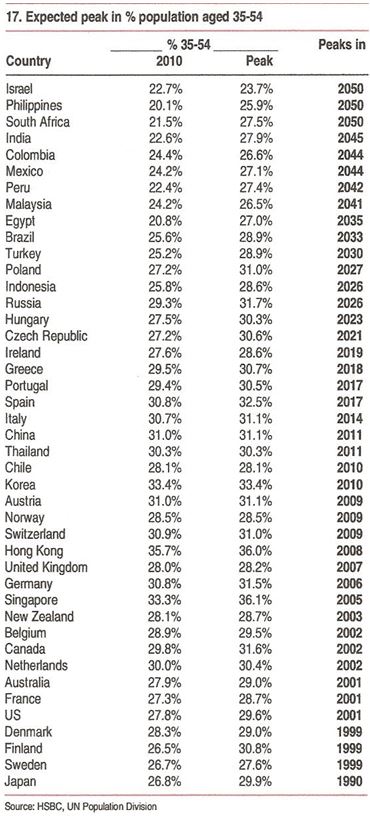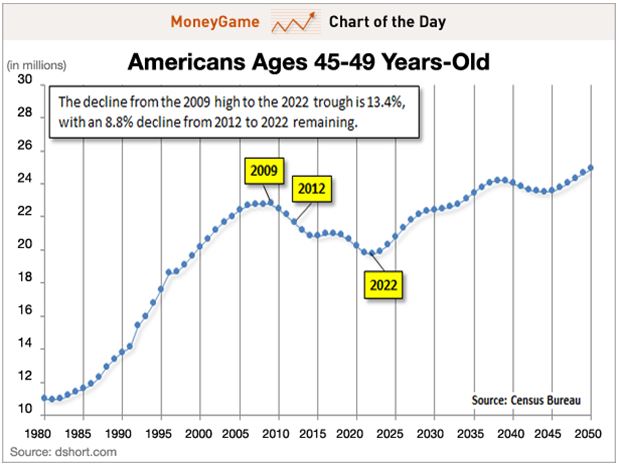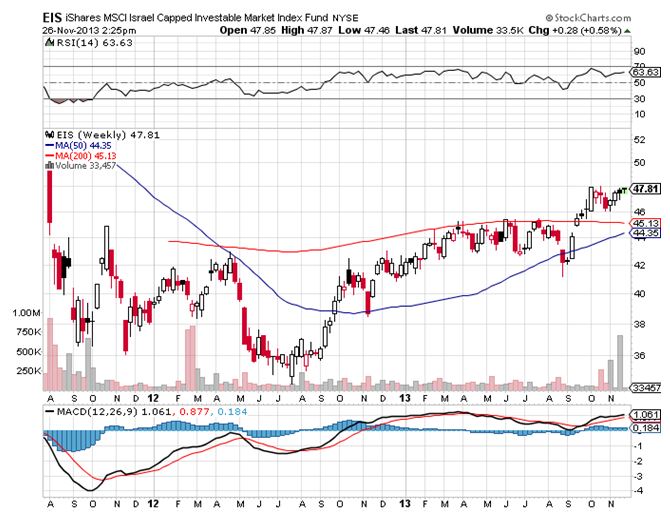If demographics is destiny, then America’s future looks bleak. At least, that is the inevitable conclusion if demographics is your only consideration.
I have long been a fan of demographic investing, which creates opportunities for traders to execute on what I call “intergenerational arbitrage”. When the numbers of the middle aged are falling, risk markets plunge. Front run this data by two years, and you have a great predictor of stock market tops and bottoms that outperforms most investment industry strategists.
You can distill this even further by calculating the percentage of the population that is in the 45-49 age bracket, according to my friend, demographics guru Harry S. Dent, Jr.
The reasons for this are quite simple. The last five years of child rearing are the most expensive. Think of all that pricey sports equipment, tutoring, braces, first cars, first car wrecks, and the higher insurance rates that go with it.
Older kids need more running room, which demands larger houses with more amenities. No wonder it seems that dad is writing a check or whipping out a credit card every five seconds. I know, because I have five kids of my own. As long as dad is in spending mode, stock and real estate prices rise handsomely, as do most other asset classes. Dad, you’re basically one giant ATM.
As soon as kids flee the nest, this spending grinds to a juddering halt. Adults entering their fifties cut back spending dramatically and become prolific savers. Empty nesters also start downsizing their housing requirements, unwilling to pay for those empty bedrooms, which in effect, become expensive storage facilities.
This is highly deflationary and causes a substantial slowdown in GDP growth. That is why the stock and real estate markets began their slide in 2007, while it was off to the races for the Treasury bond market.
The data for the US is not looking so hot right now. Americans aged 45-49 peaked in 2009 at 23% of the population. According to US census data, this group then began a 13-year decline to only 19% by 2022. This was a major reason why I ran huge shorts across all “RISK ON” assets six years ago, which proved highly profitable.
You can take this strategy and apply it globally with terrific results. Not only do these spending patterns apply globally, they also back test with a high degree of accuracy. Simply determine when the 45-49 age bracket is peaking for every country and you can develop a highly reliable timetable for when and where to invest.
Instead of poring through gigabytes of government census data to cherry pick investment opportunities, my friends at HSBC Global Research, strategists Daniel Grosvenor and Gary Evans, have already done the work for you. They have developed a table ranking investable countries based on when the 34-54 age group peaks—a far larger set of parameters that captures generational changes.
The numbers explain a lot of what is going on in the world today. I have reproduced it below. From it, I have drawn the following conclusions:
* The US (SPY) peaked in 2001 when our first “lost decade” began.
*Japan (EWJ) peaked in 1990, heralding 20 years of falling asset prices, giving you a nice back test.
*Much of developed Europe, including Switzerland (EWL), the UK (EWU), and Germany (EWG), followed in the late 2,000’s and the current sovereign debt debacle started shortly thereafter.
*South Korea (EWY), an important G-20 “emerged” market with the world’s lowest birth rate peaked in 2010.
*China (FXI) topped in 2011, explaining why we have seen three years of dreadful stock market performance despite torrid economic growth. It has been our consumers driving their GDP, not theirs.
*The “PIGS” countries of Portugal, Ireland (EIRL), Greece (GREK), and Spain (EWP) don’t peak until the end of this decade. That means you could see some ballistic stock market performances if the debt debacle is dealt with in the near future.
*The outlook for other emerging markets, like Russia (RSX), Indonesia (IDX), Poland (EPOL), Turkey (TUR), Brazil (EWZ), and India (PIN) is quite good, with spending by the middle age not peaking for 15-33 years.
*Which country will have the biggest demographic push for the next 38 years? Israel (EIS), which will not see consumer spending max out until 2050. Better start stocking up on things Israelis buy.
Like all models, this one is not perfect, as its predictions can get derailed by a number of extraneous factors. Rapidly lengthening life spans could redefine “middle age”. Personally, I’m hoping 60 is the new 40.
Immigration could starve some countries of young workers (like Japan), while adding them to others (like Australia). Foreign capital flows in a globalized world can accelerate or slow down demographic trends. The new “RISK ON/RISK OFF” cycle can also have a clouding effect.
So why am I so bullish now? Because demographics is just one tool in the cabinet. Dozens of other economic, social, and political factors drive the financials markets.
My theory is that Ben Bernanke got a hold of the best selling book, The Great Crash Ahead: Strategies for a World Turned Upside Down, by Harry S. Dent, Jr. and Rodney Johnson, and thought to himself, “Yikes, I better do whatever I can to offset this demographic drag or we’ll all be toast.” Thus followed his ultra low interest rate policy and unending waves of quantitative easing. So far, Ben has been pretty successful.
What’s more, Ben’s replacement, my friend Janet Yellen, will carry on Ben’s mission to stave off a demographic disaster until 2022. Then the demographic headwind veers to a tailwind, setting the stage for the return of the “Roaring Twenties.”
To buy Harry Dent’s insightful tome at Amazon, please click here. By the way, Australian readers should take note that we will be touring the Land Down Under to debate exactly these issues in February, 2014. Dates and times will be forthcoming.
In the meantime, I’m going to be checking out the shares of the matzo manufacturer down the street.



